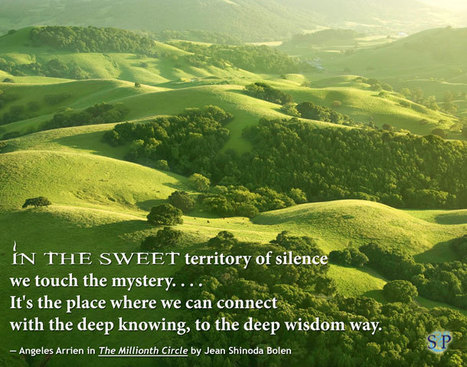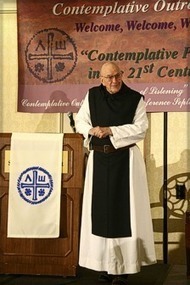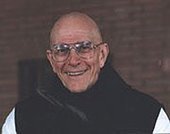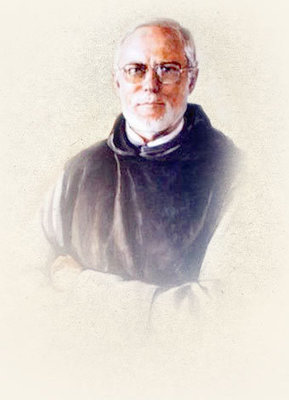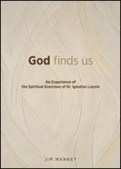 Your new post is loading...
 Your new post is loading...

|
Scooped by
Dr. Amy Fuller
August 4, 2013 4:52 PM
|
Being still is tremendously difficult in our media-rich, always-on world. Noise crowds into every empty space. Here’s how to reclaim some interior margin.

|
Scooped by
Dr. Amy Fuller
July 29, 2013 2:54 AM
|
The Interior Castle, by St. Teresa of Avila, [1921], full text etext at sacred-texts.com The Interior Castle is divided into seven mansions (also called dwelling places), each level describing a step to get closer to God. In her work, Teresa already assumed entrance into the first mansions by prayer and meditation. The first three mansions are considered to be ordinary prayer or active prayer. The first mansions begin with a soul's state of grace, but the souls are surrounded by sin and only starting to seek God's grace through humility in order to achieve perfection. The second mansions are also called the Mansions of the Practice of Prayer because the soul seeks to advance through the castle by daily thoughts of God, humble recognition of God's work in the soul and ultimately daily prayer. The third mansions are the Mansions of Exemplary Life characterized through divine grace a love for God that is so great that the soul has an aversion to both mortal and venial sin and a desire to do works of charitable service to man for the ultimate glory of God. The fourth through seventh mansions are considered to be mystical or contemplative prayer. The fourth mansions are a departure from the soul actively acquiring what it gains as God increases his role. The fifth mansions contains incipient Union in which the soul prepares itself to receive gifts from God. If the fifth mansion can be compared to a betrothal, the sixth mansion can be compared to lovers. The soul spends increasing amounts of time torn between favors from God and from outside afflictions. The soul achieves clarity in prayer and a spiritual marriage with God in the seventh mansions.

|
Scooped by
Dr. Amy Fuller
July 29, 2013 2:29 AM
|
This article is an excerpt from a chapter of Praying Scripture for a Change: An Introduction to Lectio Divina by Dr. Tim Gray The Word of God is the first source of all Christian spirituality. It gives rise to a personal relationship with the living God and with His saving and sanctifying will. It is for this reason that from the very beginning … what is called lectio divina has been held in the highest regard.

|
Scooped by
Dr. Amy Fuller
July 26, 2013 8:48 PM
|
Richard Foster in his book, Prayer, refers to this kind of meditative prayer as “prayer of the heart” (p. 141). Quiet, reflective prayers are a way to overcome the mind’s tendency to wander and get distracted. It’s a way to increase your consciousness and appreciation of God’s presence. It’s a way to “let the word of Christ dwell in your richly” (Colossians 3:16). http://www.soulshepherding.org/2012/07/breath-prayers/

|
Scooped by
Dr. Amy Fuller
July 22, 2013 1:33 AM
|
The WCCM International Website. Resources, meditation groups lists, newsletters and information on the meditation practice and all the Community activities worldwide. If we are truly attentive to the mantra we cannot image God. We cannot construct any idea or icon of God. In the context of this pure attention, pure faith, we learn that all images, ideas, memories and words fall short of the reality we are paying attention to. They are unreal. They are illusion. So in meditation we realize that God is not an absent memory or an abstract dream. God is.

|
Scooped by
Dr. Amy Fuller
July 22, 2013 1:24 AM
|
Those teaching a programme of Christian Meditation need to recognise that each child is born as a spiritual being; listen to what the child has to offer; honour each child’s relationship with the divine; always make the experience of meditation positive; and never judge the child’s meditation.

|
Rescooped by
Dr. Amy Fuller
from Meditation Practices
July 19, 2013 12:16 AM
|
With your inbox overflowing and your to-do list trailing behind you like a tall, dark shadow, you might be prone to defending your time. But the truth is that we could all benefit from breaking up our busy days with a short meditation session.
Via American Institute Health Care Professionals

|
Scooped by
Dr. Amy Fuller
July 14, 2013 1:23 AM
|

|
Scooped by
Dr. Amy Fuller
July 12, 2013 12:12 AM
|
Silence is not an absence of sound, but rather a shifting of attention toward sounds that speak to the soul. Thomas Moore in the reenchantment of everyday life.

|
Rescooped by
Dr. Amy Fuller
from Personal Spirituality
July 11, 2013 10:01 PM
|
Neurotheology explores the effect of prayer on the brain, and the results so far have been enlightening. By scanning the brain activity of people while they pray, he's found that, during meditative prayer, the frontal lobes that handle concentration “light up” and the parietal lobes that process outside sensory information “go dark.” The reaction happens in people of all different faiths
Via Hugh N Blair

|
Scooped by
Dr. Amy Fuller
July 9, 2013 8:58 PM
|
Lectio Divina, literally meaning "divine reading," is an ancient practice of praying the scriptures. During Lectio Divina, the practitioner listens to the text of the Bible with the "ear of the heart," as if he or she is in conversation with God, and God is suggesting the topics for discussion. The method of Lectio Divina includes moments of reading (lectio), reflecting on (meditatio), responding to (oratio) and resting in (contemplatio) the Word of God with the aim of nourishing and deepening one's relationship with the Divine.

|
Scooped by
Dr. Amy Fuller
July 9, 2013 8:41 PM
|
Centering Prayer description and link to Contemplative Outreach Website
|

|
Scooped by
Dr. Amy Fuller
August 4, 2013 4:32 PM
|
Centering Prayer with Father Thomas Keating, Father Carl Arico and Gail Fitzpatrick-Hopler Be still and know that I am God.”
—Psalm 46:10 Centering Prayer is a silent prayer practice that can move you toward profound relationship with the Spirit of God within. It is a way of praying that opens the door to the Divine Indwelling—the ground of our being. WithCentering Prayer, Father Thomas Keating and his colleagues Gail Fitzpatrick-Hopler and Father Carl Arico present the first in-depth home study course in this method for deepening your intimacy with God, and ultimately consenting to the presence and action of the Divine in all aspects of your life.

|
Scooped by
Dr. Amy Fuller
July 29, 2013 2:43 AM
|
The Call To Prayer-Filled Living
"Question: What is the Contemplative Tradition?
"Answer: A life of loving attention to God.
"Question: Why should we explore it?
"Answer: Because through it we experience the divine rest that overcomes our alienation.
"Every one of us is called to be a contemplative — not in the sense of a particular vocation we call 'the contemplative life,' but in the sense of a holy habit of contemplative love that leads us forth in partnership with God into creative and redeeming work.

|
Scooped by
Dr. Amy Fuller
July 29, 2013 2:24 AM
|
Sacred Reading (Lectio Divina) is a method created and first practiced by contemplative monks and hermits three to four hundred years after the time of Christ. Only recently, through the efforts of Richard Foster and a host of others, has lectio gained a foothold among Protestants, but its popularity is growing rapidly.Sacred Reading (Lectio Divina) by Gary Gilley

|
Scooped by
Dr. Amy Fuller
July 22, 2013 1:44 AM
|
Meditation and Mental Health Introduction God works in us. In meditation, we work to gradually quiet the ego so that our spirit works with His spirit as we “work out our salvation.” Father Laurence expresses in his book First Sight (2011), that salvation is about healing and becoming well. Our wellness increases as we are faithful to the practice of our daily meditation. Slowly but surely, the love of Christ, or as John Main refers to it as “a stream of love”, flows within us, from Jesus toward the Father. This stream of love transforms our ego and opens us to the Spirit. This transformation leads to healing and greater health – mental, spiritual, and physical.

|
Scooped by
Dr. Amy Fuller
July 22, 2013 1:30 AM
|
He sensed that the meeting of the great world religions could only be fulfilled if members of each faith approached each other from this depth of spiritual experience taught in their own tradition.
John Main’s way of teaching reminds us of the oral tradition in which this way of contemplative wisdom has always been transmitted. His recorded talks continue to guide meditation groups each week around the world. He was a teacher who wished to lead others into their own experience, and he believed one could teach meditation only by meditating with people. The movement from thought to experience, theory to reality, mind to heart, is central to his vision of spiritual growth.

|
Scooped by
Dr. Amy Fuller
July 22, 2013 1:15 AM
|
The WCCM International Website. Resources, meditation groups lists, newsletters and information on the meditation practice and all the Community activities worldwide. Meditation is a universal spiritual wisdom and a practice that we find at the core of all the great religious traditions, leading from the mind to the heart. It is a way of simplicity, silence and stillness. It can be practised by anyone from wherever you are on your life’s journey. It is only necessary to be clear about the practice and then to begin – and keep on beginning. http://wccm.org/content/what-meditation

|
Scooped by
Dr. Amy Fuller
July 16, 2013 12:50 AM
|
Western thinkers have tended to draw a line between reality—that which we “actually” experience—and imagination, seen as a frivolous, dreamlike diversion. For millennia, though, spiritual contemplatives and artists have taken flights of fancy much more seriously and challenged the firmness of that line. And surprising recent advances in neuroscience, particularly in the field of brain scanning, have added support to their conviction that our imagination and sense of reality are closely intertwined. The human capacity for imagination not only shapes our minds but also weaves the fabric of reality itself.

|
Rescooped by
Dr. Amy Fuller
from CALM
July 12, 2013 12:34 AM
|

|
Rescooped by
Dr. Amy Fuller
from Personal Spirituality
July 11, 2013 10:06 PM
|
Simplicity can be complicated. But its spiritual rewards are great. Members of the Lutheran Volunteer Corps (LVC) expect to make sacrifices. Giving a year of your life to serve others and living communally, often in an inner-city neighborhood far from home, will naturally require a level of selflessness.
Via Hugh N Blair

|
Scooped by
Dr. Amy Fuller
July 11, 2013 7:19 AM
|
Ignatius thought that a particular type of ignorance was at the root of sin. The deadliest sin, he said, is ingratitude.

|
Scooped by
Dr. Amy Fuller
July 9, 2013 8:46 PM
|
Christian meditation is a form of prayer in which a structured attempt is made to become aware of and reflect upon the revelations ofGod.[1] The word meditation comes from the Latin word meditārī, which has a range of meanings including to reflect on, to study and to practice. Christian meditation is the process of deliberately focusing on specific thoughts (such as a bible passage) and reflecting on their meaning in the context of the love of God.[2]
|

 Your new post is loading...
Your new post is loading...
 Your new post is loading...
Your new post is loading...















